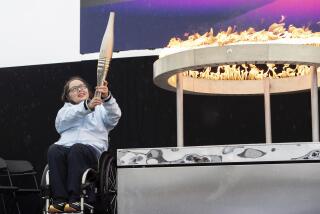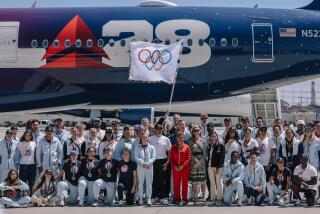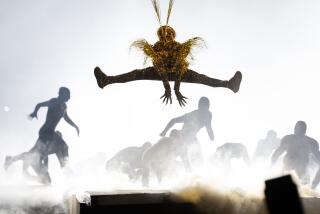WINTER OLYMPICS : The Calgary Dream Is Now Reality, but It’s a Costly Reality
- Share via
CALGARY, Canada — Speaking first in French and then in English, Canada’s Governor-General, the Right Honourable Jeanne Suave, said the 12 words Saturday that ended more than six years of anticipation. “I declare open the Games of Calgary, celebrating the 15th Olympic Games.”
She deviated slightly from the prepared text, leaving out the word winter, as in Olympic Winter Games. But the capacity crowd of 60,000 at McMahon Stadium on the University of Calgary campus did not need the Governor-General, the Queen’s representative in Canada, to announce which Games these were.
The temperature left no doubt, dropping to 28 degrees before the two-hour ceremony ended under a low, almost purple sky. A steady breeze made it seem even colder.
But the hearty Calgarians were not to be denied. This was the show they have been waiting almost 25 years to see, starting when they made the first of their three losing Winter Games bids to the International Olympic Committee in 1964. They finally were rewarded in September of 1981 in Baden Baden, West Germany, winning a majority of IOC votes over two other cities.
“The dream has become a reality,” said Frank King, chairman of the local organizing committee, Olympiques Calgary Olympics (OCO ‘88).
Actually, the dream did not equal the reality. These Winter Games are the largest--about 1,780 athletes from 57 countries--the longest--16 days, covering three weekends before the Feb. 28 Closing Ceremony--and most expensive--almost $1 billion.
Close to one-third of that bill, an Olympic record $309 million, was footed by an American television network, ABC.
Considering that, it is no mystery why the U.S. team received such a large ovation as it marched in the parade of athletes. While many Canadians may have cheered because they are good neighbors, others who have an interest in the future of the Olympic movement no doubt hoped to inspire the Americans to superior performances so that the U.S. television ratings will be high. The higher the ratings, an aide to IOC President Juan Antonio Samaranch predicted last week, the higher the networks will bid for the next Winter Games.
“The French are cheering more than ever for the Americans,” said Come Croce-Spinelli, a spokesman for the Albertville, France, Organizing Commitee, which plans to begin negotiations this summer with the U.S. networks for the rights to the 1992 Winter Games.
Although there have been predictions that the United States will win no gold medals for the first time ever in an Olympics, the Americans at least made it through the Opening Ceremony without any disappointments. That is an improvement over the 1984 Winter Games in Sarajevo, Yugoslavia, where they lost their opening hockey game the day before the torch was lit. The United States played its first hockey game here Saturday night, several hours after the Opening Ceremony, and beat Austria, 10-6.
Except for the hockey players, who watched on television from the athletes’ village, the U.S. team, the largest in the Games with 134 members, marched behind flag-bearer Lyle Nelson, 39, a biathlete from McCall, Idaho, who received a graduate degree from USC. The U.S. athletes wore either white or navy blue wool overcoats with red scarfs and wide-brimmed white fedoras.
“This is the best opening ceremony and parade I’ve ever been in, and I’ve been in a lot of them,” said Nelson, who is a member of the Olympic team for the fourth time.
Among the other prominent flag-bearers were Monaco’s Prince Albert, the driver of a four-man bobsled and an IOC member; Austria’s Leonhard Stock, the 1980 men’s downhill champion; Switzerland’s Michela Figini, the 1984 women’s downhill champion; Sweden’s Thomas Wassberg, a two-time Olympic champion in cross-country skiing, and the Soviet Union’s Andrei Bukin, who, along with partner Natalia Bestemianova, is a world champion ice dancer.
The largest ovation, naturally, was reserved for Canada, which, even though it is the home team, has five fewer athletes here than the United States. Marching at the end of the parade, the Canadians were led by flag-bearer Brian Orser, the 1987 world champion in figure skating.
All of the athletes entered the stadium to find a football field covered with white sand imported from British Columbia. Fearing there would be no snow, the organizers thought that was the best way to assure a winter look for the estimated 1.5 billion people watching a worldwide television feed.
Contributing to the effect, each of the 60,000 spectators was given a different colored poncho, creating the look of five Olympic rings--red, blue, green, yellow and black--against a white background.
About the only mystery before the ceremony was whether a former or a current Canadian Olympic athlete would ignite the Olympic flame, thus ending the 88-day, 11,160-mile torch run across Canada.
It was neither. As the torch entered the stadium, it was passed to two former Canadian Olympians, Alpine skier Ken Read, a member of the original Crazy Canucks in the ‘70s and early ‘80s, and Cathy Priestner, a speed skater in the ‘70s. They passed it temporarily to Rick Hansen, who has hand-powered his way across four continents in a wheelchair, and then on to Robyn Perry for the final leg.
Perry, 12, is a seventh-grader at St. Bonaventure Junior High School in Calgary and a junior figure skater.
“We looked for a Calgarian who represented the future,” said Robert J. Sampson, executive producer of the Opening Ceremony. “Robyn personified what we had to express.”
She tiptoed to reach the caldron, lighting the flame that will burn over Calgary for the next two weeks.
That set off the city’s church bells and sirens; a group of Aboriginal Canadians beat drums and sang; and nine Snowbirds--Canada’s version of the Blue Angels--passed over the stadium, colored smoke streaming from their tailpipes.
Nevertheless, it was a quiet Opening Ceremony compared to the one in Los Angeles in 1984. That one was high-tech and Hollywood. This one was low-key and Canadian.
“It was just like Canada,” said Matthew Fisher, The Toronto Globe and Mail’s Western Canada correspondent. “It was organized but not spectacular.”
It started with representatives of five North American Indian tribes in native dress riding onto the field on painted ponies. Originally, an OCO official suggested they chase a chuckwagon, presumably commandeered by cowboys, and then whoop and holler as they burn it to the ground.
Insulted by the stereotype, the Indians replied that they would burn the chuckwagon only if the OCO official were in it.
OCO officials had problems in preparing for these Games--a ticket scandal, local discontent over the unavailability of tickets to the select events, internal bickering, difficulty in choosing a site for the Alpine skiing, various interest groups using the attention focused on Calgary to further their own causes and trademark infringements. Then, there was the constant worry about whether the weather would cooperate, giving them snow and enough cold to preserve it.
But that is all behind them now. Polls show that more than 90% of Calgary’s 640,000 citizens support the Games, the weather is as miserable as everyone had hoped the Games have begun.
“You get the Olympics only once in a lifetime,” Calgary Mayor Ralph Klein said. “It’s like the mumps.”
More to Read
Go beyond the scoreboard
Get the latest on L.A.'s teams in the daily Sports Report newsletter.
You may occasionally receive promotional content from the Los Angeles Times.







